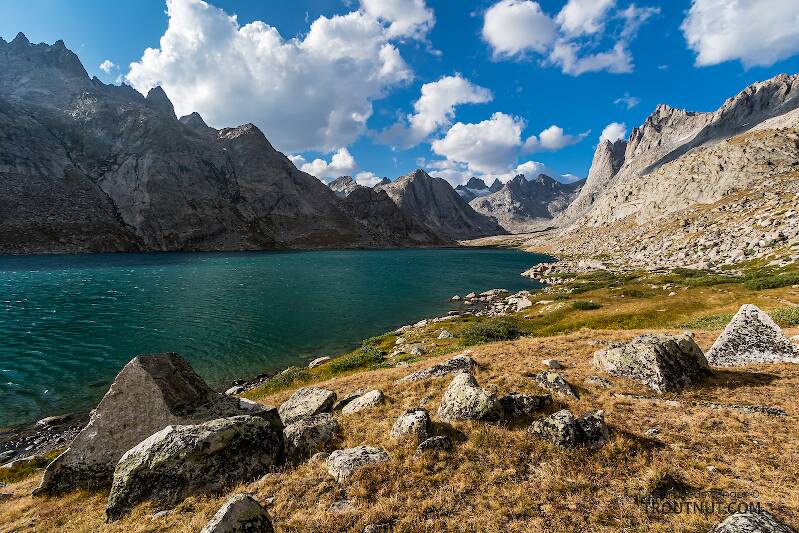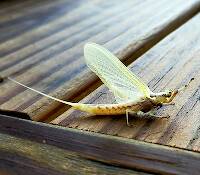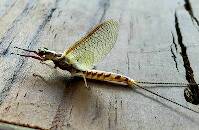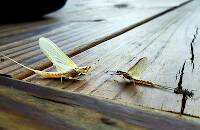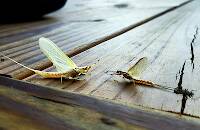
Hex Mayflies
Hexagenia limbata
The famous nocturnal Hex hatch of the Midwest (and a few other lucky locations) stirs to the surface mythically large brown trout that only touch streamers for the rest of the year.
Featured on the forum

This specimen resembled several others of around the same size and perhaps the same species, which were pretty common in my February sample from the upper Yakima. Unfortunately, I misplaced the specimen before I could get it under a microscope for a definitive ID.

Troutnut is a project started in 2003 by salmonid ecologist Jason "Troutnut" Neuswanger to help anglers and
fly tyers unabashedly embrace the entomological side of the sport. Learn more about Troutnut or
support the project for an enhanced experience here.
Softhackle on Aug 20, 2007August 20th, 2007, 8:49 am EDT
I've not done any studies, but I see a difference in the way a fly sits on the water. I can tell that splaying the tail helps it to sit upright, better. It stabilizes the fly, even in the classic Catskill design flies.(I will note, here that if you do splay the tails on a Catskill design fly, it may, buy some, no longer be considered "Catskill style". I will also note I consider the term "Catskill Style" inaccurate.) I also feel specific designs of flies must have, at least, splayed tails in order to perform as designed.
Mark
Mark
"I have the highest respect for the skilled wet-fly fisherman, as he has mastered an art of very great difficulty." Edward R. Hewitt
Flymphs, Soft-hackles and Spiders: http://www.troutnut.com/libstudio/FS&S/index.html
Flymphs, Soft-hackles and Spiders: http://www.troutnut.com/libstudio/FS&S/index.html
Softhackle on Aug 20, 2007August 20th, 2007, 11:45 am EDT
Hi Wbranch,
I agree with you and say that's a very good description. I have had some very involved discussions regarding "the Catskill Style". I know a few very educated fly fishers/tiers that disagree that this "style" even exists. With me, however, It is somewhat a matter of semantics. I prefer "Catskill Design" rather than "style". To me, style is something akin to a fad or particular embellishment or something very fleeting and unlasting-transient. A design is something more lasting and functional.
Mark
I agree with you and say that's a very good description. I have had some very involved discussions regarding "the Catskill Style". I know a few very educated fly fishers/tiers that disagree that this "style" even exists. With me, however, It is somewhat a matter of semantics. I prefer "Catskill Design" rather than "style". To me, style is something akin to a fad or particular embellishment or something very fleeting and unlasting-transient. A design is something more lasting and functional.
Mark
"I have the highest respect for the skilled wet-fly fisherman, as he has mastered an art of very great difficulty." Edward R. Hewitt
Flymphs, Soft-hackles and Spiders: http://www.troutnut.com/libstudio/FS&S/index.html
Flymphs, Soft-hackles and Spiders: http://www.troutnut.com/libstudio/FS&S/index.html
Softhackle on Aug 21, 2007August 21st, 2007, 1:56 am EDT
Wbranch,
Their flies would definitely fit into the "Catskill Design" category, but you have to realize that their flies were based on flies designed by tiers that came before them like Rube Cross, who was the first commercial tier in the Catskills and who, along with Roy Steenrod and Herman Christian , set the standard for Catskill flies. These gentlemen were students of Theodore Gordon. many of Gordon's flies were based on flies created in England, which is why some tiers will argue that there really is no "Catskill Style or Design".
Mark
Their flies would definitely fit into the "Catskill Design" category, but you have to realize that their flies were based on flies designed by tiers that came before them like Rube Cross, who was the first commercial tier in the Catskills and who, along with Roy Steenrod and Herman Christian , set the standard for Catskill flies. These gentlemen were students of Theodore Gordon. many of Gordon's flies were based on flies created in England, which is why some tiers will argue that there really is no "Catskill Style or Design".
Mark
"I have the highest respect for the skilled wet-fly fisherman, as he has mastered an art of very great difficulty." Edward R. Hewitt
Flymphs, Soft-hackles and Spiders: http://www.troutnut.com/libstudio/FS&S/index.html
Flymphs, Soft-hackles and Spiders: http://www.troutnut.com/libstudio/FS&S/index.html
Troutbum13 on Sep 5, 2008September 5th, 2008, 9:22 am EDT
Actually, Rube Cross was not the first commercial tyer in the Catskills. It was George W. Cooper. It was in the 1870s when he was tying flies for sale.
Leakywaders on Sep 7, 2008September 7th, 2008, 9:42 am EDT
The "NEARNUF" (HG Tapley) uses a pair of split feather quills for tail, that way the fly is stablized, rides upright, etc.
On the other hand, if the fly falls over it looks like a stillborn, or cripple, and may get more strikes. I think tha would be a "good mistake" Maybe it is becouse our flies are such poor imitations, that they are successful. i,e, the hook looks like a trailing shuck. The wing that goes cockeyed on the first cast, then catches fish, etc.
On the other hand, if the fly falls over it looks like a stillborn, or cripple, and may get more strikes. I think tha would be a "good mistake" Maybe it is becouse our flies are such poor imitations, that they are successful. i,e, the hook looks like a trailing shuck. The wing that goes cockeyed on the first cast, then catches fish, etc.
Drag free??? If the fly didn't drag, I wouldn't know where it was!!
Quick Reply
Related Discussions
Topic
Replies
Last Reply
16
Sep 22, 2011
by Oldredbarn
by Oldredbarn

